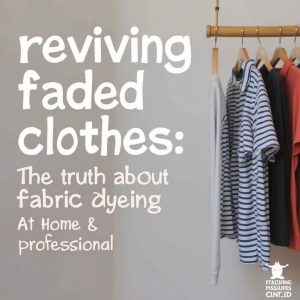Reviving Faded Clothes: The Truth About Fabric Dyeing at Home and Professional Services.
Why Clothes Lose Their Colour
Clothes fade or lose their colour for many reasons, and understanding these causes can help you prevent damage and extend the life of your wardrobe.
Reviving Faded Clothes: The Truth About Fabric Dyeing begins with recognising the factors that lead to colour loss.
1. Bleach and Harsh Cleaners
Bleach is one of the most common causes of sudden colour loss. Even a tiny splash of chlorine bleach can leave a permanent white mark on your clothing. Other strong cleaning sprays, disinfectants, or chemicals may also strip the dye from fabrics. This usually happens accidentally while cleaning the house.
Using fabric dyeing techniques can help in reviving faded clothes that have suffered from bleach damage.
Tip: Always wear old clothes or an apron when cleaning with bleach or strong chemicals, and keep your laundry area separate from cleaning products to prevent mishaps.
2. Sunlight and Washing
Washing clothes too often, especially in hot water, slowly breaks down the dye and weakens the fibres. Bright sunlight also fades colour over time, particularly in natural fabrics like cotton, linen, and silk. This is why clothes that are hung outside or left in sunny windows tend to lose colour faster.
To prevent fading, consider the methods for reviving faded clothes. The truth about fabric dyeing is knowing when to wash and how.
Example: Dark jeans that are frequently left to dry in direct sunlight will start looking grey and dull after a few months.
3. Normal Wear and Tear
Even high-quality garments will eventually fade over time. Over time, the fibres weaken, colours lose their vibrancy, and clothes begin to look worn out. This is a natural process caused by friction, washing, and exposure to the elements.
Reviving faded clothes through proper care can significantly extend the lifespan of your garments.
Fact: Clothes with darker colours, like black or navy, usually show fading more noticeably than lighter shades.
What Is Fabric Dyeing?
Reviving Faded Clothes: The Truth About Fabric Dyeing Techniques
Fabric dyeing is the process of adding new colour to clothing. It can be used to:
Reviving faded clothes through fabric dyeing allows you to experiment with various colours and regain vibrancy.
-
Bring back faded colours to make clothes look new again.
-
Cover up bleach spots or uneven patches.
-
Completely transform a garment by changing its colour entirely.
Example:
A pair of black jeans with bleach spots can be dyed black for a uniform look. A faded red dress can be revived with a fresh, deep red shade. Some people even choose to dye their clothes to follow new fashion trends or to give an old garment a completely new style.
Reviving faded clothes often involves selecting the right colour for the dyeing process, which is crucial for the desired outcome.
Does Dyeing Hurt the Fabric?
A common concern people have about dyeing is whether it will weaken or damage their clothing. The answer depends on the method used.
-
Professional dyeing is safe because it utilises high-quality dyes and employs proper techniques that safeguard the fabric.
Understanding the differences between home and professional methods is vital to reviving faded clothes: the truth about fabric dyeing lies in the technique used.
-
Home dyeing can sometimes harm the fabric, mainly if the wrong chemicals or extreme heat are used during the process.
Key idea: Professional services tailor the dyeing process to the specific type of fabric, keeping it strong and safe while restoring its colour.
Pro tip: Before dyeing, professionals test a small area of the garment to ensure the colour will take evenly and safely.
How Long Will the Colour Last?
The lifespan of a dyed garment depends on three main factors:
Reviving faded clothes can depend significantly on the care taken after the dyeing process to maintain the vibrancy.
1. The Type of Dye
-
Home dye kits are affordable and easy to use, making them great for beginners. However, they usually don’t penetrate deeply into the fabric fibres. This means the colour may look nice at first, but can fade quickly after a few washes. Home kits often come with limited colours and may not include the additives that help set the dye permanently.
-
Professional dyes, on the other hand, are specially formulated to bond deeply with different types of fibres. These dyes often involve advanced steps, such as pre-treatments, setting agents, and controlled temperature processes, to ensure the colour is even, vibrant, and long-lasting. Professional services also mix custom shades and test the fabric beforehand to make sure the final colour matches the customer’s expectations.
2. The Fabric Type
-
Natural fibres like cotton, silk, and wool absorb dyes really well, resulting in rich and even colours. These fabrics tend to have open structures that allow dye molecules to penetrate deeply. Cotton shirts, wool sweaters, and silk scarves can often be restored beautifully with the proper dyeing process, giving them a like-new appearance. However, care must still be taken with delicate natural fibres to avoid shrinkage or texture changes.
Reviving faded clothes made of natural fibres usually yields the best results when using fabric dyeing techniques.
-
Synthetic fabrics, such as polyester, nylon, and acrylic, are more difficult to dye because they repel water-based dyes. They may need special treatments, such as heat setting or dispersal dyes, to hold the colour properly. Blended fabrics, such as polyester-cotton mixes, can be especially tricky, as the natural part dyes well, but the synthetic part may remain pale or unchanged. This is why professional dyeing services are beneficial for synthetics and blends, as they ensure even coverage and a consistent final look.
3. Care After Dyeing
Taking care of your dyed clothes will help them stay vibrant and maintain their rich colour for as long as possible. Proper aftercare begins immediately after the dyeing process:
After dyeing, reviving faded clothes responsibly means following guidelines to preserve the newly dyed colour.
-
Wash them in cold water with mild, gentle detergent to prevent colour bleeding and fabric damage. Cold water helps lock in colour molecules and keeps fabrics looking new.
-
Avoid tumble drying on high heat, as this can weaken both the fabric and dye, leading to shrinkage or uneven fading. If possible, air dry on a flat surface or use a low-heat setting.
Reviving faded clothes requires attention to storage and maintenance to prevent future colour loss.
-
Store clothes away from direct sunlight to prevent fading over time. Sunlight can break down dye molecules and cause colours to dull.
-
Turn garments inside out before washing to protect the outer surface of the fabric from friction and fading.
-
Avoid using bleach or strong stain removers on dyed garments, as they can quickly strip away the new colour.
-
If possible, hand-wash delicate or expensive items to keep them in excellent condition.
Many people opt for professional services to revive faded clothes because these services offer expertise in fabric dyeing.
Bottom line: Professionally dyed garments stay bright and beautiful for much longer compared to clothes dyed at home, especially when you follow these careful maintenance steps.
DIY vs. Professional Dyeing
When deciding whether to dye clothes yourself or hire a professional, it’s helpful to know the pros and cons of each option. This decision depends on factors such as the type of garment, its sentimental or financial value, the complexity of the colour change, and your comfort level with following detailed instructions. For example, a simple cotton T-shirt can often be dyed successfully at home. Still, a delicate silk dress or wool coat requires specialised care and equipment that only a professional cleaner can provide. Understanding the differences will help you avoid costly mistakes and select the method that yields the best results.
Dyeing at Home
Pros:
Reviving faded clothes can be a rewarding experience, especially when utilising fabric dyeing correctly.
-
Inexpensive and easy to buy, kits are available online or in stores, making them accessible to almost everyone, even beginners.
-
Great for small, simple projects like T-shirts, pillowcases, tote bags, or even casual cotton dresses that you want to refresh.
-
Fun and creative activity for experimenting with tie-dye, ombré effects, or custom patterns, especially for group projects with friends or family.
-
Provides a sense of satisfaction and learning experience by allowing you to see the transformation process and develop basic fabric care skills.
Cons:
When evaluating the drawbacks of DIY dyeing, reviving faded clothes often yields mixed results compared to professional methods.
-
A higher risk of uneven, streaky, or blotchy results can occur if the dye is not appropriately mixed or the fabric isn’t fully prepared before starting.
-
Limited colour selection compared to professional dyes, which can make it harder to match specific shades or restore an exact original colour.
-
Not safe for delicate fabrics like silk or wool, as these can shrink, warp, or tear easily during home dyeing.
-
Colours often fade quickly after just a few washes, especially if proper aftercare steps aren’t followed.
-
It can be messy and time-consuming, requiring careful setup to protect your work area and prevent spills.
-
It may not fully cover deep stains or bleach spots, leaving visible marks even after multiple attempts.
Reviving faded clothes with home dye kits can sometimes lead to disappointment if not executed properly.
Example:
Someone tries to cover the bleach marks on their jeans at home. Initially, the jeans look better, but after two or three washes, the spots return and the jeans look worse than before.
Extra tip: Always wear gloves and protect the area you’re working in because DIY dye can permanently stain surfaces and your hands.
Professional Dyeing
Pros:
With professional dyeing, reviving faded clothes becomes an art form, ensuring satisfaction with the final results.
-
Expert care: Professionals know exactly which dye works best for each fabric type and will conduct tests to ensure the right colour match before starting.
-
Deep, long-lasting colours that stay vibrant, as they use advanced dyes and controlled processes that penetrate the fabric thoroughly.
-
Safe for expensive or delicate garments because professionals handle each item carefully, preventing damage to fine fibres like silk or wool.
-
Can restore clothes to near-original condition, reviving faded fabrics and bringing old pieces back to life.
Reviving faded clothes through expert dyeing services showcases the skill behind fabric dyeing.
-
Custom shade matching is possible, allowing them to recreate discontinued or unique colours.
-
Professionals can also address uneven colouring issues and tackle challenging tasks such as blending fabrics or heavily stained areas.
Cons:
-
It costs more than DIY dye kits, which may make it less appealing for people on a tight budget or for inexpensive garments.
-
Takes more time because garments need to be carefully prepared and processed, including cleaning, testing for colour compatibility, and sometimes multiple dyeing stages.
-
Requires planning and possibly multiple visits if additional services, such as stain removal or repairs, are needed before dyeing.
Reviving faded clothes can take time, but the results from professionals are often worth the wait.
-
Not all fabrics or colours can be perfectly matched, so there may be slight variations that need to be discussed with the professional beforehand.
Example:
A faded silk blouse is brought to a professional cleaner. The expert uses special dyes and equipment to bring back its original colour without damaging the delicate silk fibres.
Pro insight: Many professional services also offer stain removal and restoration before dyeing, ensuring the garment looks flawless.
Understanding when to opt for DIY versus professional dyeing is essential for successfully reviving faded clothes.
When to Choose DIY vs. Professional
Here’s how to decide which option is right for you, with more detail to guide your decision:
-
DIY dyeing is best for cheap, casual clothes or fun, creative experiments. It works well for items like cotton T-shirts, pillowcases, or tote bags, where the results don’t need to be perfect. It’s also an excellent choice for kids’ crafts or trendy tie-dye projects.
-
Professional dyeing is worthwhile for valuable, delicate, or sentimental garments, such as wedding dresses, vintage coats, designer pieces, or family heirlooms. Professionals have the tools to handle complex fabrics and exact colour matching.
Extra considerations: Think about the fabric type, the original colour, and whether the garment has stains or uneven fading. Complex blends or heavily worn fabrics often need a professional’s expertise.
When making a choice, consider how important it is to revive faded clothes compared to the effort of dyeing them yourself.
Simple rule: If you would be upset or frustrated if the garment were ruined, take it to a professional cleaner. If it’s a low-stakes project or an inexpensive piece, DIY may be the best option.
Example: A beloved vintage coat or expensive evening gown is better off in the hands of a professional, while old cotton T-shirts or thrift store finds are perfect for experimenting at home.
Final Thoughts
Reviving faded clothes not only enhances their appearance but also contributes to sustainable fashion practices.
Fabric dyeing is a fantastic way to save and refresh your clothes instead of discarding them. It’s sustainable, budget-friendly, and can completely transform your wardrobe. By choosing to dye instead of discarding, you’re reducing waste, saving money, and giving your garments a second life.
Whether you revive faded clothes through fabric dyeing or let them go, the choice is yours.
-
DIY dyeing is fun and affordable, but best for simple projects and casual pieces where perfection isn’t necessary.
-
Professional dyeing offers top-quality, long-lasting results and keeps your garments safe while delivering expert colour matching and protection.
Reviving faded clothes is an eco-friendly way to prolong the life of your wardrobe.
Fabric dyeing also supports sustainable fashion by promoting reuse over buying new. This helps reduce pollution caused by textile production and encourages mindful shopping habits.
At Hampstead Garment Care, we specialise in professional fabric dyeing. Our expert team works carefully to bring your clothes back to life, preserving their texture and quality. From basic cotton shirts to luxury silk gowns, every garment receives personalised care and detailed attention, including pre-treatment, colour testing, and expert finishing.
Our services focus on revitalising faded clothes: the truth about fabric dyeing lies in our meticulous approach to each item.
Call to Action: Don’t let your favourite clothes fade away in the back of your closet. Trust us to restore them and make them look beautiful again, focusing on reviving faded clothes: the truth about fabric dyeing.
Call to Action:
Book your fabric dyeing service now and let us restore your favourite clothes to their former glory. Schedule a consultation today and see how we can transform your wardrobe with professional, eco-friendly fabric dyeing.




No comment